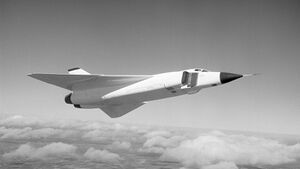TAI FI-107 Eriyum Ampu
| TAI FI-107 Eriyum Ampu | |
|---|---|

| |
| Role | Interceptor |
| Manufacturer | Tennai Aerospace Industries |
| First flight | 25 March 1958 |
| Introduction | 20 February 1962 |
| Retired | 1995 (RTAF) |
| Status | Retired |
| Primary user | Tennai |
| Produced | 1961 - 1985 |
| Number built | 1,937 |
The TAI FI-107 was a delta-winged interceptor aircraft designed and built by Tennai Aeropace Industries. The FI-107 was capable of achieving Mach 2 speeds at altitudes exceeding 50,000 feet (15,000 m) and served as served as the primary interceptor of the RTAF until 1995 when the TAI GF-20 Berunda took over the interceptor role.
The Eriyum Ampu was the culmination of a series of design studies begun in 1953 that examined improved versions of the Sripaada Aircraft FI-90. After considerable study, the RTAF selected a dramatically more powerful design, and serious development began in 1955. The aircraft was built directly from the the production line, skipping the tradtional hand-built prototype phase. The first Eriyum Ampu MK 1 was rolled out to the public on 4 October 1957.
Flight testing began with the MK 1 on 25 March 1958, and the design quickly demonstrated excellent handling and overall performance, reaching mach 1.9 in level flight. Powered by the Gikrabanda K77, another three MK. 1s were completed. The lighter and more powerful Nanda Naga was soon ready for testing, and the first MK 2 with the Naga was ready for taxi testing in preparation for flight and acceptance tests by RTAF pilots by early 1959.
By January of 1961, the MK 2 was accepted as the initial producion variant of the FI-107 and serial production began in July of 1961 following final flight testing.
Development
Design
Operators
Upgrades
Variants
- FI-107 A
- Intitial production variant
- FI-107 B/C
- FI-107 D
- Interceptor and fighter variant. Upgraded the engines to the more powerful Nanda Naga II engines rated at 142 kN (32,000 lbf). The engine intakes were redesigned and the wings were strengthened. Four underwing weapon stations were added, two under each wing, which supplemented the internal weapons bay and a KE PR-NG 17 pulse-doppler fire-control radar was installed.
Users
Specifications (Eriyum Ampu A)
General characteristics
- Crew: 2
- Length: 26.1 m (85 ft 8 in)
- Wingspan: 15.2 m (49 ft 10 in)
- Height: 6.5 m (21 ft 4 in)
- Wing area: 113.8 m2 (1,225 sq ft)
- Empty weight: 19,235 kg (42,406 lb)
- Gross weight: 28,319 kg (62,433 lb)
- Max takeoff weight: 31,119 kg (68,606 lb)
- Powerplant: 2 × Nanda Naga afterburning turbojet, 82.3 kN (18,500 lbf) thrust each dry, 116 kN (26,000 lbf) with afterburner
Performance
- Maximum speed: 2,453 km/h (1,524 mph; 1,325 kn)
- Maximum speed: Mach 2+
- Cruise speed: 1,128 km/h (701 mph; 609 kn)
- Range: 2,660 km (1,653 mi; 1,436 nmi)
- Combat range: 1,330 km (826 mi; 718 nmi)
- Ferry range: 3,990 km (2,479 mi; 2,154 nmi)
- Service ceiling: 18,288 m (60,000 ft)
- Thrust/weight: 0.83
Armament
- Missiles:
- Various short, medium, and long range AAMs
- Nuclear missiles